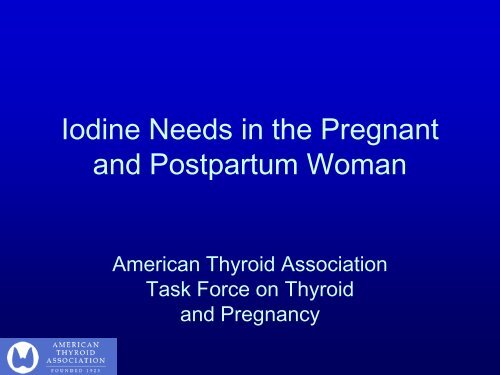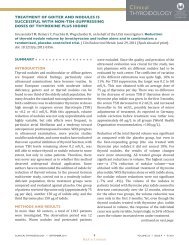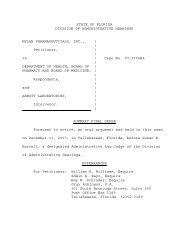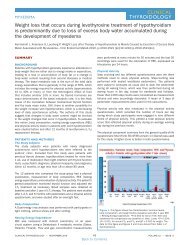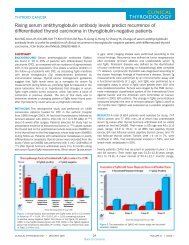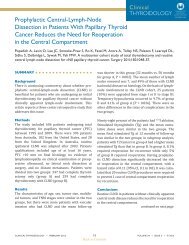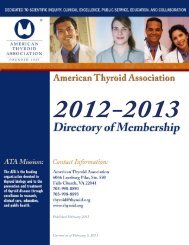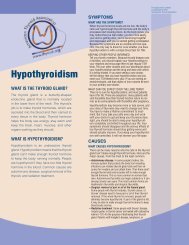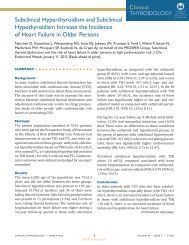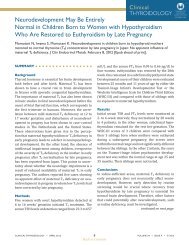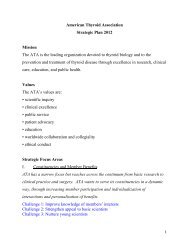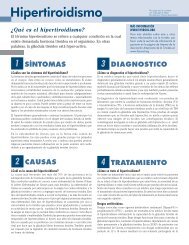Iodine Needs in the Pregnant and Postpartum Woman - American ...
Iodine Needs in the Pregnant and Postpartum Woman - American ...
Iodine Needs in the Pregnant and Postpartum Woman - American ...
Create successful ePaper yourself
Turn your PDF publications into a flip-book with our unique Google optimized e-Paper software.
<strong>Iod<strong>in</strong>e</strong> <strong>Needs</strong> <strong>in</strong> <strong>the</strong> <strong>Pregnant</strong><strong>and</strong> <strong>Postpartum</strong> <strong>Woman</strong><strong>American</strong> Thyroid AssociationTask Force on Thyroid<strong>and</strong> Pregnancy
Increased thyroid hormone production (↑ 50%),:- Thyrotropic regulation by hCG- Estrogen-mediated TBG <strong>in</strong>creaseIncreased Maternal Dietary <strong>Iod<strong>in</strong>e</strong> Requirements<strong>in</strong> PregnancyIncreasedrenal iod<strong>in</strong>eclearance(↑ 30-50%)Iodide transferred to <strong>the</strong> fetus
Increased Dietary <strong>Iod<strong>in</strong>e</strong> Requirements<strong>in</strong> Lactation• Normal lactat<strong>in</strong>g breast ductsconcentrate iodide (via sodiumiodide symporter), secret<strong>in</strong>g it<strong>in</strong>to milkTazebay et al Nat Med 2000; 6:859-60• Only source of iod<strong>in</strong>e nutritionfor breastfed <strong>in</strong>fants
Effects of <strong>Iod<strong>in</strong>e</strong> Deficiency• Maternal Risks• Goiter• Hypothyroidism• Risks to Fetus/Child• Miscarriage• Stillbirth• Congenital anomalies• Per<strong>in</strong>atal <strong>and</strong> <strong>in</strong>fant mortality• Cret<strong>in</strong>ism• Reduced IQICCIDD/UNICEF/WHO
<strong>Iod<strong>in</strong>e</strong> Deficiency <strong>and</strong> Reduced IQ• Worldwide, <strong>the</strong> lead<strong>in</strong>g cause of preventablemental h<strong>and</strong>icap; 30 million children bornunprotected annuallywww.WHO.<strong>in</strong>t/WHOSIS• Average 12 po<strong>in</strong>t IQ reduction <strong>in</strong> <strong>in</strong>fants ofseverely iod<strong>in</strong>e deficient womenM Qian et al. Asia Pac J Cl<strong>in</strong> Nutr 2005;14:32-42.• Societal costs: A loss of 1 IQ po<strong>in</strong>t reduces <strong>the</strong>potential <strong>in</strong>come earn<strong>in</strong>g capacity of <strong>the</strong> childby 2.39%Lisa et al. Public Health Rep 2005; 120: 607–613.
Recommended U.S. <strong>Iod<strong>in</strong>e</strong> IntakeAge GroupRecommendedI 2 <strong>in</strong>take (μg/day)Adults 150<strong>Pregnant</strong> womenLactat<strong>in</strong>g women220290Adolescents 150Children 1-8y, 9-13y, >14y 90, 130, 1500-6months & 7-12m 110 & 130Institute of Medic<strong>in</strong>e 2001
Tolerable Upper Limit for Daily <strong>Iod<strong>in</strong>e</strong>IntakeAdults (<strong>in</strong>clud<strong>in</strong>g pregnancy) – 1100 ug/day“ <strong>the</strong> highest average daily nutrient <strong>in</strong>take levelthat is likely to pose no risk of adverse heal<strong>the</strong>ffect to almost all <strong>in</strong>dividuals <strong>in</strong> <strong>the</strong> generalpopulation.”Institute of Medic<strong>in</strong>e 2001
Population Ur<strong>in</strong>ary <strong>Iod<strong>in</strong>e</strong> Values <strong>and</strong><strong>Iod<strong>in</strong>e</strong> NutritionPopulation groupNon-pregnantadultsMedian Ur<strong>in</strong>ary <strong>Iod<strong>in</strong>e</strong>Concentration (μg/L)OptimalExcessive100-199 >299<strong>Pregnant</strong> Women 150-249 ≥500Lactat<strong>in</strong>g Women≥100WHO Public Health Nutr 2007
Median Ur<strong>in</strong>e <strong>Iod<strong>in</strong>e</strong> Concentration (μg/L)Median U.S. Ur<strong>in</strong>ary <strong>Iod<strong>in</strong>e</strong>Concentrations: NHANES 1971-2004400350320300250Total200150145168 160MalesFemales1005001971-74 1988-94 2001-02 2003-04Hollowell et al. JCEM 1998; 83:3401-8; Caldwell et al.Thyroid 2005; 15: 692-9 & 2008;18:1207-14.
% of U.S. Population with Ur<strong>in</strong>ary <strong>Iod<strong>in</strong>e</strong>
Percent with UI
National Academy of Science“Although iodide deficiency is believed to be rare <strong>in</strong><strong>the</strong> United States, some pregnant women may havea low iodide <strong>in</strong>take. The committee believes thatfur<strong>the</strong>r research is needed to measure moreprecisely <strong>the</strong> extent of, <strong>and</strong> risk factors for, iodidedeficiency, particularly <strong>in</strong> pregnant women <strong>and</strong> <strong>the</strong>iroffspr<strong>in</strong>g. However, while studies are be<strong>in</strong>gconducted, <strong>the</strong> committee emphasizes <strong>the</strong>importance of ensur<strong>in</strong>g that all pregnant womenhave adequate iodide <strong>in</strong>take <strong>and</strong>, as a first step,recommends that consideration be given to add<strong>in</strong>giodide to all prenatal vitam<strong>in</strong>s.”National Research Council, Health Implications ofPerchlorate Ingestion, 2005
<strong>American</strong> Thyroid AssociationRecommendations 2006• “Until additional physiologic data areavailable to make a better judgment, <strong>the</strong><strong>American</strong> Thyroid Associationrecommends that women receive 150 mcgiod<strong>in</strong>e supplements daily dur<strong>in</strong>gpregnancy <strong>and</strong> lactation <strong>and</strong> that allprenatal multivitam<strong>in</strong>/m<strong>in</strong>eralpreparations conta<strong>in</strong> 150 mcg of iod<strong>in</strong>e.”Thyroid 2006;16:949-51
Proportion of U.S. Prenatal Multivitam<strong>in</strong>sConta<strong>in</strong><strong>in</strong>g <strong>Iod<strong>in</strong>e</strong>Non-prescriptionprenatal multivitam<strong>in</strong>s(n = 127)69%(n=87)conta<strong>in</strong>iod<strong>in</strong>e28%(n=27)conta<strong>in</strong>iod<strong>in</strong>ePrescription prenatalmultivitam<strong>in</strong>s(n = 96)Leung et al. N Engl J Med 2009;360:939-40
Sources of <strong>Iod<strong>in</strong>e</strong> <strong>in</strong> U.S. PrenatalMultivitam<strong>in</strong>s<strong>Iod<strong>in</strong>e</strong> from Kelp• Measured iod<strong>in</strong>e content <strong>in</strong> 25 br<strong>and</strong>s:33 – 610 mg/daily dose.• 14 had iod<strong>in</strong>e levels 50% discordantwith labeled valuesPotassium Iodide• Mean measured iod<strong>in</strong>e content per dailydose <strong>in</strong> 35 br<strong>and</strong>s was 119.0 ± 13.6 (SE) mg,equivalent to 76% of <strong>the</strong> labeled KI.Leung et al. N Engl J Med 2009;360:939-40


